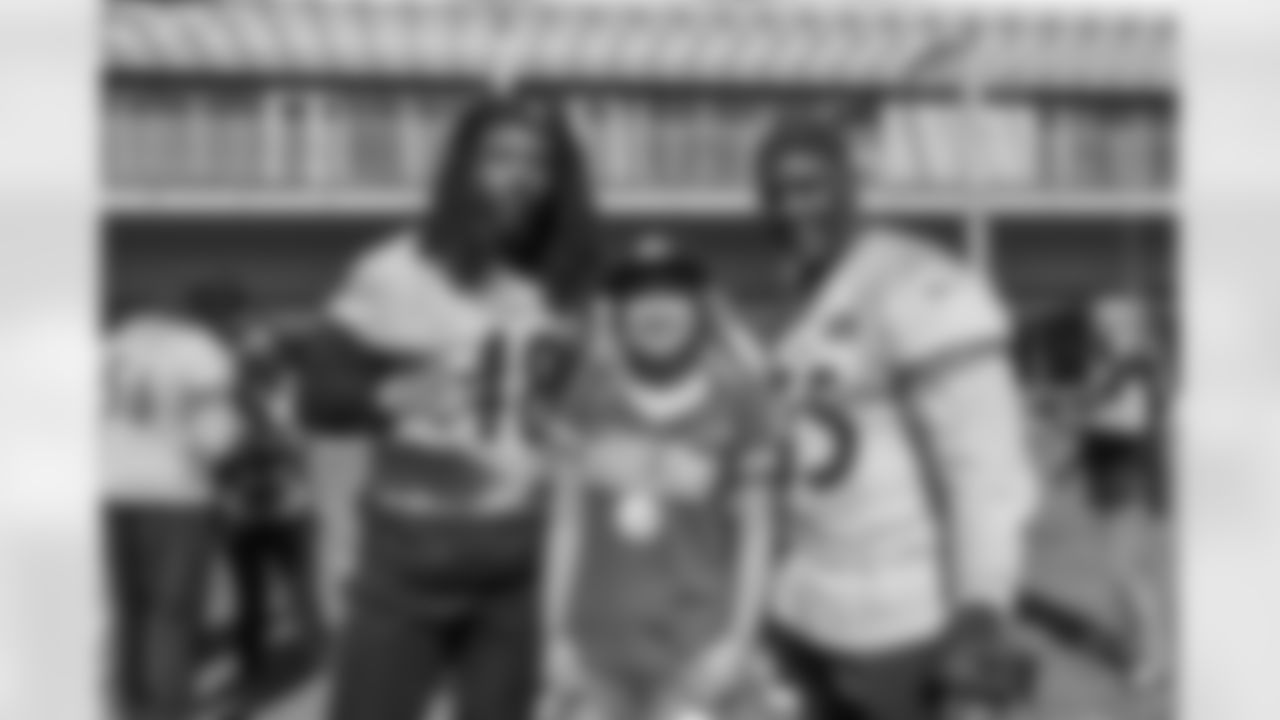**
The Steelers grant the wish of a young fan from Rudioso, NM.



























Q. I'd like to ask you to help me understand individual defensive statistics. What's the difference between a tackle and an assist?**
A. The initial hit, as opposed to a secondary hit. Particularly in close-quarter run game, often there are multiple tacklers on a ball carrier. The initial hitter is credited with a tackle. Any secondary hitter is credited with an assist.
Q. If a player sacks the quarterback, is that also a tackle for loss?
A. It is.
Q. Is a sack also a pressure?
A. It's a hit. The term that we use today is quarterback hit. That's how they measure them.
Q. What qualifies as a pass defensed?
A. A breaking up of a ball. The batting of a ball. It could be a cornerback breaking up a route, and it also could be a lineman batting the ball at the line of scrimmage. It's hand on the football.
Q. Is an interception also a pass defensed?
A. It is.
Q. Do you and your staff compile your own defensive statistics by grading video, or do you use the press box stats as reference?
A. We do it off video. Years ago, there used to be a dramatic difference between what you got from a press box and what you saw on video. Not nearly as much anymore. Not nearly as much of a discussion. But years ago when I broke into the league you could see drastic differences between the press box statistics and the ones you could do off video.
Q. The team has two locker rooms. The one here at the UPMC Rooney Sports Complex that's used daily by the players, and the one at Heinz Field that's used on game days only. How are the lockers assigned at the complex?
A. It's somewhat mystical. There is no definitive procedure. Often times, it's done by request. For instance, this year Ben Roethlisberger requested that T.J. Watt and James Conner have lockers next to his, and so they do. He gets an opportunity to interact with those young people and maybe positively affect their growth and development as players and as men. Often, it's stories such as that one that comprise the configuration of our daily locker room. It's not by position. In fact, we're thoughtfully non-rhythmic. It's really a collection of stories like the one I just told you.
**
Photos from Rock Steelers Style 2017: Football, Family & Fun at Stage AE.




























































































































































































































































































































Q. In the situations where players have roommates – training camp, hotel rooms at home or on the road – how are those pairings determined?**
A. Generally, it's positional, with some exceptions based on unique relationships. But usually it's positional.
Q. Can players pick their own roommates?
A. Yes.
Q. Bengals coach Marvin Lewis made an in-season change to his staff when he fired offensive coordinator Ken Zampese and elevated quarterback coach Bill Lazor into that job, and the move seems to have energized their offense. Have you ever considered an in-season change to your staff?
A. I haven't, but strange things happen in our business, and I think what Coach Lewis said is true that Kenny suffered the consequences of collective failure. And often that's the case. I look at it from that perspective. We're all in this thing together. We all have a hand in it. We all have ownership of it.
Q. What could convince you to make such a move?
A. It would probably be a non-football circumstance that would be the only thing that would push me in that direction.
Q. Is there a distinction in your mind between a dirty play and a play that results in a fine from the league office?
A. It depends. The fine is on a schedule, often based on a penalty but it doesn't have to be. Plays that are penalized, particularly in the 15-yard category, are going to be fined 100 percent of the time.
Q. When it comes to dirty, is that something where you know it when you see it?
A. Dirty is subjective, absolutely. It has to do with intent, but the judgment of intent is a very difficult thing. That's why we try not to officiate it. That's why 15-yard penalties are fined on a schedule, because to judge someone's intent is a very difficult task.
Q. When it comes to discipline, there are penalties, there are fines, and then the possibility of suspensions, and also the possibility of ejections. As a football coach, what are you not in favor of in terms of those punishments?
A. The ejection of players. We just don't have enough. It has to be something egregious, I think, to eject someone from a game because there just aren't a lot of men on the sideline and on the field playing. There are consequences for those who are left when you eject someone from the game.
Q. How is Steelers-Bengals different than Steelers-Ravens in terms of the type of rivalry it is?
A. I don't know that it is for us. It's an honor to be in the midst of these things, to have these types of rivalries with division teams. But for us we seek an AFC North championship, and what that brings is an automatic berth in the playoffs and the pursuit of a Super Bowl. Often these rivalries are based on teams having similar goals.
Q. But are the kinds of games against these two rivals different?
A. It's very similar. It's these complex individual relationships with people you compete against and the shared history. We had history with Ray Lewis, and we're developing history with Vontaze Burfict, for example. It's just a part of competitive people chasing the same things.
**
Q. If you were still a defensive backs coach, what would you be telling your guys about A.J. Green?**
A. To disrupt his vertical path when given an opportunity. We have to do that, whether it's zone, man-to-man, fire-zone pressure. We have to be cognizant of where he is on the field at all times, and when the call prescribes, disrupt his natural vertical movement upfield.
Q. The Steelers were looking for pass-rush help in the most recent draft and chose T.J. Watt in the first round. When scouting that group of players, what did you learn about Carl Lawson?
A. He's got things that you covet. He's a football enthusiast. He likes the life, not only the lifestyle. He likes to lift, he likes to train, he likes to study the game. It was fun visiting with him and talking with him, because he talks so definitively about the people he has studied. He had a lot of questions about William Gay. He thought they had similar physical makeups and so he had studied James' game. Often in casual conversations like that with a young man, it's very revealing about their willingness to commit, their buy-in in terms of what they're chasing. I was really impressed by him through that process because of those conversations, and I'm not surprised that he's having the success that he's having.
Q. When scouting college players to be edge rushers in the NFL, what are you looking for them to already have coming into the league, and what do you think you can teach them once they get to this level?
A. I'm looking for a distinguishing trait and knowledge of that distinguishing trait. Pass rushers come in different shapes and sizes and skill-sets. It's important that a guy has a tool that allows him to win and win consistently, a fastball, a No. 1 pitch, and he has to be aware of what that pitch is. Over the years I've come to look for that. I think some guys are speed guys, some guys are power guys, some guys are hand technicians, some guys' feet dominate the action. It doesn't matter what form they come in as long as they have knowledge of what their skills and assets are.
Q. What about what you can teach them once they get into the league?
A. You can teach them counters off that. You can teach them a repertoire, if you will, a way to keep people off balance. If you're a power rusher, you teach them how to use that power rush and transfer to speed. If you're a speed rusher, you teach them how to make people sit light and transfer speed to power. All in an effort to round out your total rush game. I make continual parallels between that and a Major League pitcher – how does he balance and supplement his No. 1 pitch with a few others to keep people off balance. It's a very similar thing from a rush standpoint.
Q. How many pitches do you need in this league?
A. It depends on how good your No. 1 pitch is. If you have a 104 mile-per-hour fastball, you don't need much else.
Q. Vontaze Burfict is a lightning rod because of the extracurriculars and the fines and suspensions he has received as a result. But when you watch him on video, what kind of a player is he?
A. He's a really good player. I don't get caught up in some of that other perspective. I respect the player he is. It's really simple – he's got tremendous instincts and he packs a punch. That's a combination that's unique and makes him a dynamic player. He's got a great feel for the game in the way he diagnoses running plays and even in the way he drops in pass coverage. He really doesn't get enough credit for his coverage abilities. He's an all-down linebacker, even though he doesn't look like one. He looks like a 9-on-7 linebacker. His instincts allow those things to happen, and he packs a punch. He wins almost all physical confrontations. When he hits people, they go backwards. At the linebacker position, you can't put a price tag on that.














